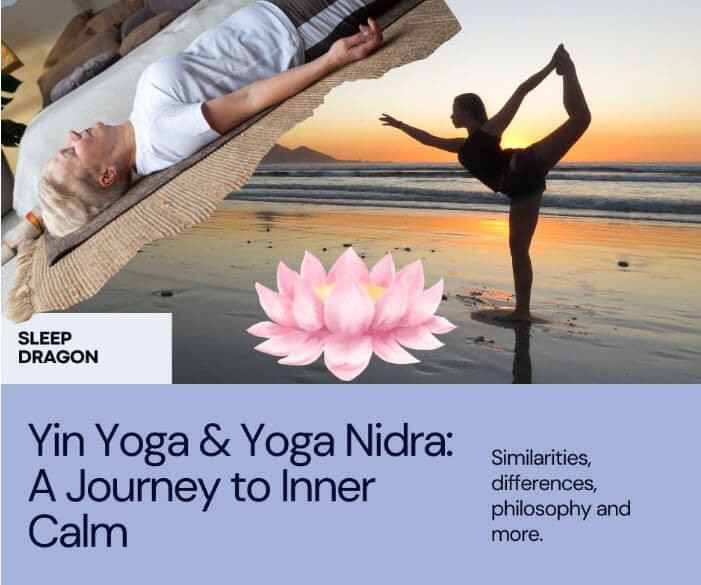An Exploration of Yoga Nidra vs.Yin Yoga –How are they different and similar
This blog is my own unintentional experiences with Yin Yoga and Yoga Nidra. “Yoga nidra is the yoga of aware sleep. In this lies the secret of self healing. Yoga Nidra is a pratyahara technique in which the distractions of the mind are contained and the mind is relaxed.” ~ Satyananda Saraswati
“The essence of yin is yielding. Yang is about changing the world; yin accepts the world as it is. Neither is better than the other. There are indeed times when it is appropriate and even necessary to change the world; other times, it is best to just allow things to unfold. Part of the yin practice is learning this yielding.” ― Bernie Clark
Yoga Nidra Vs. Yin Yoga – Differences between the two
Prepare for a yoga journey with more laughs than a sitcom and a little wisdom than that hopefully will inspire you to dive into this journey. We’re looking into the mystical realms of Yin Yoga and Yoga Nidra, using the ancient scrolls of scientific research and some experimentation with this practice after teaching in this space for more than 15 years.
Enter the serene landscapes of Yoga Nidra and Yin Yoga – two practices that beckon seekers into the realms of stillness and introspection. As we embark on this exploration, we peel back the layers of conscious relaxation and mindful stretching, unveiling the subtle yet profound differences between Yoga Nidra and Yin Yoga.
If you also interested in difference between Yoga Nidra and NSDR. See our article here.

If you interested in difference between Yoga Nidra and Meditation. See our article here.

Yin and Yang of Yoga: Yin Yoga Vs Yoga Nidra Round 1
Imagine a pint-sized Zen baby (spoiler alert: me) blissfully snoozing in a makeshift shavasana, unknowingly perfecting the art of Yoga Nidra. Back then, I thought I was just taking epic naps, not realizing I was on the express train to toddler tranquility. My grandfather would sit with me for hours teaching me the difference between meditation, Yogic sleep and the sacred yogic texts. Meanwhile, as I grew up to realize, these different pieces of the puzzle fit so wonderfully with each other to make a holistic practice of movement, breathwork and mindfulness.
Yin Yoga Deconstructed:
In the world of Yin Yoga, poses are held for extended periods, often ranging from 3 to 5 minutes or even longer. These poses primarily target the deep connective tissues, such as ligaments and fascia. The practice involves gentle stretches, favoring a meditative approach over muscular engagement. Sequences can include poses like Butterfly, Child’s Pose, and Sphinx, offering a delightful mix of challenge and calm. YIn Yoga is highly restorative and rejuvenating. It is almost always slow and mindful yet one is constantly in flow from one pose to another with long pauses in between.
Approaching Yin Yoga requires patience and an acceptance of stillness.To reap the full benefits, practitioners should focus on finding ease in discomfort, using props for support, and gradually deepening into poses as the body relaxes. The key is surrender, letting go of tension and allowing gravity to guide the stretch.
Yoga Nidra Unveiled:
Yoga Nidra, on the other hand, is the art of conscious relaxation. Often practiced in shavasana, the yogic sleep aims to guide practitioners to a state between wakefulness and slumber. This technique comes in various forms, each rooted in different schools of thought. Traditional Yoga Nidra follows a systematic relaxation approach, while other variations may include visualization and body scanning.
Yogic sleep is said to be an amazing practice to learn new things, enhance memory and improve creativity and memory retention. It has many benefits worth exploring and is one of the most relaxing practices in the yogic repertoire.
History of Yoga Nidra and Yin YOGA
Yoga Nidra is all about that savasana life – no complex poses, just me, sometimes my friends, and a potent mix of soothing music and silence. It’s like the difference between organizing a marathon and binge-watching a comedy series; one is a journey, the other, a wondrous ride into the crazy spaces that is your mind. Here is how these amazing traditions started.
Historical Roots of Yin Yoga and Yoga Nidra:
Yin Yoga’s Philosophy:
Yin Yoga originated in the late 1970s when martial arts expert and yoga teacher Paulie Zink combined Taoist philosophy with traditional Hatha Yoga. The practice gained popularity in the 2000s, offering a counterbalance to more dynamic yoga styles.
Yin Yoga draws inspiration from the balance of opposing forces, the concept of Yin and Yang. It involves holding passive poses for extended periods, targeting deep connective tissues, and fostering stillness. The practice encourages surrender and acceptance, teaching that true strength emerges from yielding to discomfort, and mindful presence in each pose cultivates inner harmony.
Yoga Nidra Philosophy: ( difference with Yin Yoga)
Yoga Nidra, with roots dating back to ancient yogic texts like the Upanishads, evolved as a formal practice in the mid-20th century. Swami Satyananda Saraswati played a pivotal role in systematizing and popularizing Yoga Nidra through his teachings in the Bihar School of Yoga.
Rooted in ancient yogic traditions, Yoga Nidra, or yogic sleep, unfolds as a guided meditation leading practitioners into a state between wakefulness and slumber. It seeks to unveil the true nature of self, guiding individuals through layers of consciousness. The philosophy revolves around deep relaxation, facilitating profound mental, emotional, and physical rejuvenation. The practice invites a journey within, fostering self-awareness, and inviting a transformative exploration of the inner landscape.
Experts today, enlighten us on Yin Yoga’s superhero status and say that it promotes flexibility and joint mobility. Meanwhile, researchers claim that 30 mins of Yoga nidra is equivalent to 4 hours of deep sleep. But let me tell you, even mini 10 minute Yoga Nidra sessions have had profound effects. The benefits? A serene demeanor, calm and still mind and that feeling of serendipity. What can one ask for?
Picture the mat as a comedy stage for Yin Yoga – think elongated poses, wobbles, and possibly some dramatic sighs. In contrast, my Yoga Nidra self is a comedy of errors, as I dozed off mid-savasana with no regard for yoga etiquette. Who knew naptime could be so avant-garde? What woke me up was my neighbor’s snoring symphony.
The Magical Neuro-physiological impact of Yoga Nidra and Yin
Yin Yoga is the superhero for “joint health, circulation, and emotional well-being” while Yoga Nidra is the perfect blue pill for healing, better sleep at night, stress management and more.Journal entries from yoga enthusiasts read like a detective’s notebook, detailing the subtle nuances of how these practices sneakily infiltrate their lives and transform stress into tranquility.
Both Yin Yoga and Yoga Nidra have distinct neurophysiological impacts, influencing the nervous system and brain in unique ways.
Yin Yoga:
1. Parasympathetic Activation: Yin Yoga, characterized by long-held, passive poses, triggers the parasympathetic nervous system. This activation induces a relaxation response, reducing stress hormones like cortisol. The prolonged stretch signals the body to relax into the pose, promoting a state of calm.
2. Fascial Stimulation: The practice involves gentle stretching of connective tissues, particularly the fascia. This stimulation may improve the elasticity and hydration of fascial structures, promoting joint mobility and overall flexibility.
3. Mind-Body Integration: The meditative aspect of Yin Yoga encourages mindfulness and present-moment awareness. This mental focus can influence neural pathways related to stress perception, fostering a mind-body connection that contributes to overall well-being.
Yoga Nidra:
1. Shift to the Relaxation Response: Yoga Nidra, often referred to as yogic sleep, induces a state between wakefulness and sleep. This practice promotes the relaxation response, leading to a decrease in sympathetic nervous system activity. This shift is associated with reduced heart rate, blood pressure, and decreased levels of stress hormones.
2. Brain Wave Patterns: Studies indicate that during Yoga Nidra, there is a transition in brain wave patterns, particularly an increase in theta wave activity. Theta waves are associated with deep relaxation, meditation, and heightened creativity. This altered state of consciousness contributes to the profound relaxation experienced in Yoga Nidra.
3. Improved Sleep Quality: Regular practice of Yoga Nidra has been linked to improved sleep quality. The guided nature of the practice helps individuals release tension and quiet the mind, contributing to better sleep patterns and addressing conditions like insomnia.
Common Ground: Similarity Yin Yoga & YOga Nidra
1. Reduction in Cortisol Levels: Both practices, in their own ways, contribute to a reduction in cortisol levels. The extended holds in Yin Yoga and the guided relaxation in Yoga Nidra help mitigate the physiological effects of stress, promoting an overall sense of calm.
2. Enhanced Parasympathetic Dominance: Both Yin Yoga and Yoga Nidra foster an environment conducive to parasympathetic dominance. This physiological state supports rest, rejuvenation, and the body’s natural healing processes.
In summary, while Yin Yoga emphasizes the physical aspects of stretching and myofascial release, Yoga Nidra delves into the mental and emotional realms through guided relaxation. Together, they offer a holistic approach to neurophysiological well-being, providing tools for stress reduction, improved sleep, and an enhanced mind-body connection. Incorporating both practices into a wellness routine can create a harmonious synergy, addressing different facets of the intricate interplay between body and mind.So, its not hard to gift yourself with a lifetime membership to the Serenity Club and if you already have a little bit of yoga in your life, then upgrade to explore an advanced practice today. There’s nothing quite like one on one guidance. Yoga Nidra allows me to dive into a conscious relaxation that transcends the boundaries of age, all while embracing my inner child – and maybe sneaking in a nap or two.
Yoga Nidra and Yin Yoga- a symbiotic approach
This exploration unveils the multifaceted dimensions of Yin Yoga and Yoga Nidra. They are two adjunct therapies that can co-exist beautifully. One can lead to the other- movement into stillness and leave one feeling fresh and de-stressed. To understand this concept in more detail find more yogic concepts here.
From therapeutic landscapes to methodical approaches, historical contexts to personal experiences, these practices offer a holistic approach to well-being. As researchers, it is imperative to bridge the scientific rigor with the human elements, recognizing the potential for profound insights in the transformative journey of inner exploration through both Yin and Yog Nidra.


